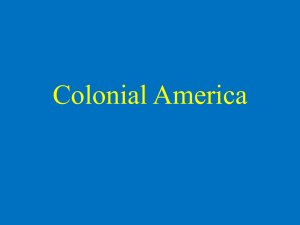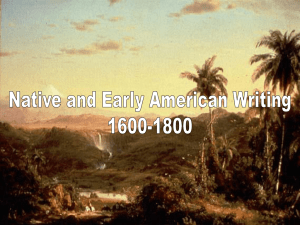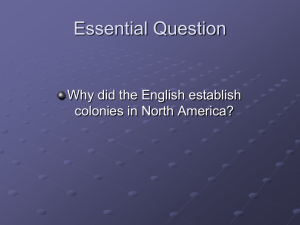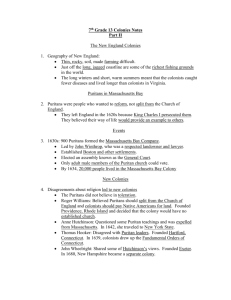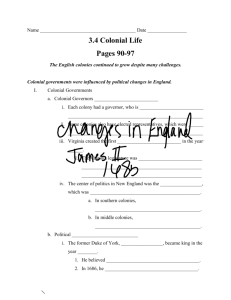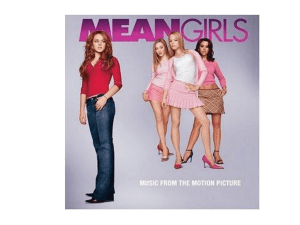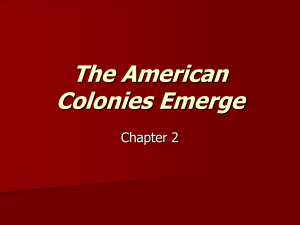PPT on the first colonies
advertisement
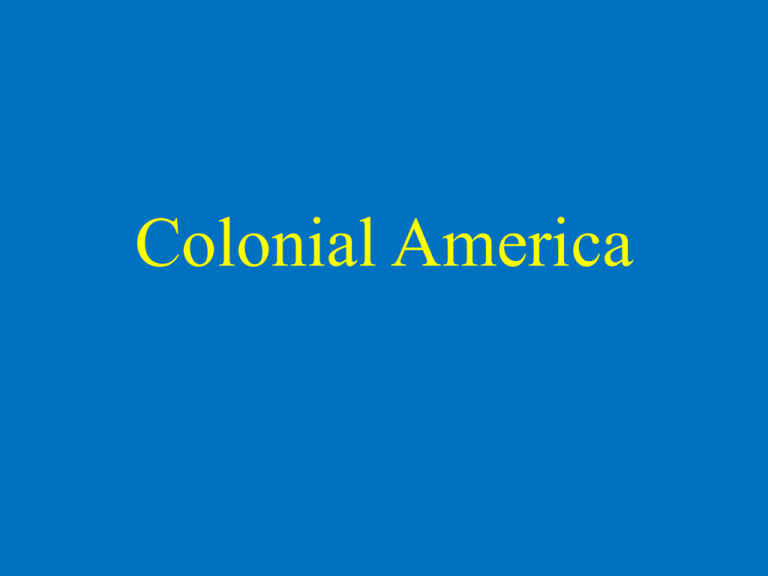
Colonial America Early Attempts • Vikings reach Canada – 1000AD • Spanish • Columbus 1492 • Ponce de Leon reaches Florida 1513 • St. Augustine 1565 • British • Roanoke 1580s • Jamestown 1607 Recreated Norse Sod Longhouse Why Britain colonized America • Land Pressures in Britain – Enclosures – Population Growth • Trading Companies • Mercantilism – Strengthen state through trade, resources – Competition with other empires (Spain, France) And also… • Religion – Freedom of Practice (Puritans) – Spreading Christianity Roanoke • Raleigh received Charter 1584 • Grenville arrives with settlers Spring 1585 • Left in August, 1585 • 75 men left behind, promised to return in next spring • He was late returning, so in June,1586, Drake (he was passing by) taxied colonists back to England • Grenville returns soon after, leaves men again • 1587, Grenville sent 117 more in under John White • • • • Found 1 skeleton! White’s daughter gave birth to Virginia Dare George Howe is killed while crabbing John White returned to England for help1587 • Did not return until 1590! (War, then pirating) Chartered Companies (Early 1600s) • London Company (Virginia) • Cape Fear, NC to Long Island • Plymouth Company (Pilgrims) • Chesapeake Bay to New Brunswick Jamestown & Colonial Virginia • Jamestown founded in 1607 by London Co. • Followed 30 years of failed efforts • Bad spot – powerful Indian tribes, swamps • By 1624 only 1,300 of first 8,500 colonists still alive Major Milestones in Virginia • • • • Began to plant tobacco (1612) First Africans arrive as labor (1619) First representative assembly (1619) Virginia Co. bankrupt, crown takes control (1624) • Population begins to grow; 8,000 by 1640 Major Milestones in Virginia • Indian tribes and colonial government agree on line separating control along Blue Ridge Mountains (1644) • Colonial population continues to grow (16,000 by 1650, 40,000 by 1660) and colonists keep moving west • Tensions between colonists in east, west Colonial Massachusetts • Pilgrims land far north of Virginia in 1620 • Other Puritans follow – 1,000 in 1630 under Mass. Bay Co. • John Winthrop seeks “City Upon a Hill” (theocracy?) Pilgrims 1620 Puritans 1630 Jamestown 1607 The Puritans of Massachusetts Origins of Puritanism • Reform movement in English Anglican Church, began around 1560 • Movement a response to view that: – Anglican Church structure too hierarchical – Religious practices too close to Catholicism Major Puritan Beliefs • Original Sin – Humans by nature sinful; they can only achieve grace through self-examination and self discipline. • Emphasis on Community – Community had right to make sure members adhered to community standards and expectations. • Predestination – Person born as one of the elect (will go to heaven) or not. Best evidence? Live life rightly. Evidence of a Life Lived Rightly • Public confession of an experience of conversion • Being a good member of the faith, following its moral codes • Being frugal, self reliant and hard-working – Ideally leads to wealth Politics in Puritan Massachusetts • Theocracy? Yes & No • Puritan men had influence in selecting church leaders • Puritan men had vote in selecting colony’s elected assembly • Emphasis on education, schools The end of Puritan control • As colony’s population grew, it also grew more diverse (more non-Puritans) • After 62 years, charter of 1692 gave all males the right to vote • However, Puritan cultural influence remains – Emphasis on hard work, democracy, education, ‘exceptional’ nature of society (City Upon a Hill) Diverse Colonies • Unlike Va. and Mass. most colonies “proprietorships” • Maryland – Founder Catholic but most colonists Protestants • New York diverse (English, Dutch, German, French, etc.) Diverse Colonies • Pennsylvania founded by Quaker, prospered from start, good relations with Indians • Georgia last established (1733), created as barrier to Spanish, home for poor of England Similarities across colonies • • • • Most people work in agriculture (80%) Representative assemblies take root Less class-based than in England More social mobility than in England – Land plentiful, laborers not Differences: North and South Southern Colonies •Good agricultural lands •Large-scale agriculture •Slavery extensive, expanding •Little manufacturing •Religion less important Northern Colonies •Not as bountiful •Small-scale agriculture •Slavery fades •Rifles, furniture, ships, lumber, fishing •Religion central
